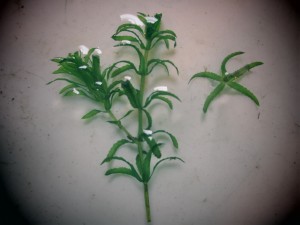Fisherman And Boaters Asked To Be Aware Of New Threat
The Crawford County Conservation District (CCCD) is asking anglers and boaters to be aware of a new threat to our area waterways. A highly invasive plant called Hydrilla has been found in Pymatuning Lake and is spreading within the reservoir. Hydrilla resembles other water plants commonly referred to as “seaweed” already found in area waterways. What makes hydrilla especially damaging is its ability to grow very rapidly (up to 1” per day) and expand into areas that other aquatic plants don’t typically grow. Hydrilla also grows in extremely dense, extensive mats that are nearly impossible to boat through, swim or fish within. As of now hydrilla has only been found in Pymatuning Reservoir within Crawford County, and is thought to be in the early stages of infestation. The next closest known infestation is Lake Arthur in Butler County. However, there is fear by resources managers that it will quickly spread from Pymatuning to other local waterways. Hydrilla spreads by plant fragments, and can easily be carried on boats and trailers that move from one waterway to another. If allowed to spread to other waterways hydrilla has the ability to negatively impact the boating and fishing experience in Crawford County, as well as have a damaging impact on tourism that we so desperately depend on.
Since there are other aquatic invasives in Crawford County waterways the CCCD recommends that all boaters and anglers, regardless of the waterbody they are on take time to remove plant fragments from boats and trailers before leaving the boat launch. Equipment, including bilges and livewells should be dried thoroughly before entering a new waterway. If boaters want to move from one waterway to another before equipment has a chance to dry they should at least run their boat and trailer through a car wash or better yet, hot water pressure wash equipment before launching into a new waterway.
The CCCD is also asking anyone who thinks they have seen hydrilla in waterways other than Pymatuning Reservoir to immediately report their finding to Brian Pilarcik at 814-763-5269 or brian@crawfordconservation.org . If possible take a close up picture of the suspected find, as well as a detailed description of the location. GPS coordinates would be very helpful in confirming a suspected find.
Fact Sheet: http://www.paseagrant.org/wp-content/uploads/2012/11/hydrilla2013_reduced.pdf
Background:
- Hydrilla is listed as a federally noxious weed. Possession, sale and transport are illegal.
- The plant is thought to be native to Asia. It was first introduced to Florida in the 1950’s and has been spreading northward.
- Hydrilla in the US annually costs millions of dollars of in management and lost tourism revenue.
- Hydrilla is not currently known to be in any of the Great Lakes. The Pymatuning infestation is one of the closest infestations to the Great Lakes watershed currently known.


